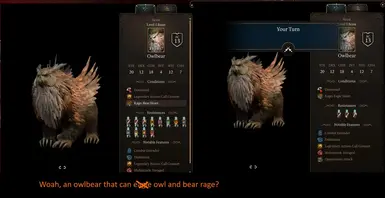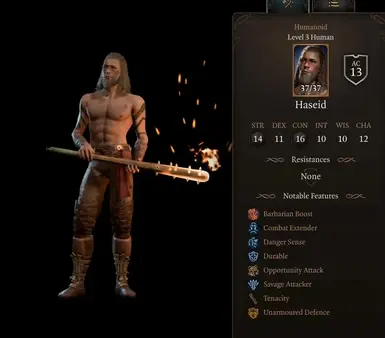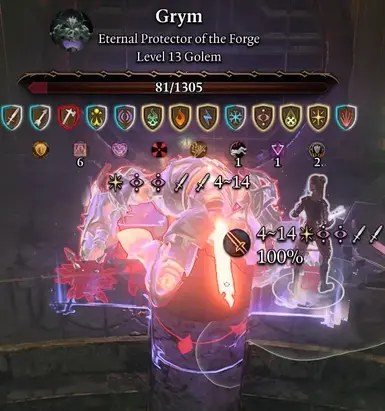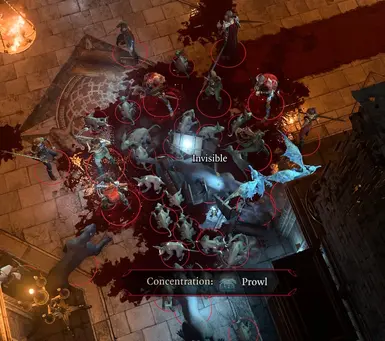About this mod
Like the old "Ajax most comprehensive CX ever" updated to cover more mods and incorporate important community overhauls.
I humbly submit for your consideration, what I believe is likely *the* most comprehensive Combat Extender config files in existence for your use, your reference, and your pleasure.
- Requirements
- Permissions and credits
The absolutely necessary mods to get ~80% of Combat Extender to behave as designed are Action Resource Passives by ckalp67, Goon's Passive Library by BaldursGoonsack, and Ultimate NPC Stat Overhaul (also by Goon).
=================
Update 24 April 2025
The download is now packaged with an "Easy CombatExtender.json" and "Hard CombatExtender.json" alongside the regular one. Only use whichever file appeals to you, make sure it is named (or renamed!) "CombatExtender.json," and install it to %appdata%/local/larian studios/baldurs gate 3/Script Extender, or install it to SE_CONFIG (if using MO2).
Easy Mode slightly increases the stats and HP of allies, and slightly decreases the stats and HP of enemies. Many strong abilities, resistances, and tweaks made to enemies are removed, and overall less pre-encounter strategy/prep (or reloading a save and trying a fight again) will be necessary compared to the base file. The most powerful spells and rule-breaking/cheating abilities are taken away from enemies.
Hard Mode noticeably increases the stats, HP, and rolls of bosses. It slightly increases the stats and HP of regular enemies, and slightly reduces the benefits for allies (though they will still be better than pure vanilla). Hard mode also removes many of the intentional buffs that the baseline file uses to offset certain enemies, such as adding psychic vulnerability to many Act 1 enemies or Aversion to Fire to many undead, animals, spiders, and plants.
=================
It is hard to capture exactly the scope of the effects and consequences of Ultimate NPC Stat Overhaul. Not only does this mod normalize/standardize a lot of fiddly issues across the entire game (like making enemies react consistently to dangerous surfaces and poisonous clouds, making sure everyone who should have darkvision actually does, etc) - it deepens the flexibility and application of Combat Extender considerably. Rather than labeling some enemies as "Fighter" / "Ranger" / "Wizard," a much larger list of NPCs in the game are now appropriately tagged, and the tags include more specifics to differentiate Eldritch Knight-type gish enemies from Battle Master-type fighters. Necromancers, Evokers, Sorcerers, Warlocks, and Bards are now all different sets of abilities and spells (base Combat Extender only has one "CX_Magic_Boost" label and gives all arcane spell casters the same set of abilities/changes). Barbarians are split up between berserkers and wild magic. Etc. This means, basically, that you should see some parts of the game homogenized for consistency with things like racial features; and you should see some parts of the game feel MUCH more diverse as gith fighters are very different from human necromancers are very different from ogre barbarians. This is a WIP project that overtime should helpfully continue to differentiate the experience of fighting different enemies in more interesting ways. And as always, the number of boosts enemies have increase in Act 2 and Act 3.
ARP and GPL provide necessary passives to give enemies things such as damage vulnerabilities and resistances, extra actions or bonus actions, increased or decreased movement, access to class feature resources like superiority dice and barbarian rage charges, etc. If you download Combat Extender, ARP, and GPL, and place UNSO after CX in your load order, the provided CX config files will substantially cover most of your game with enemies tweaked and improved and changed to refresh your next playthrough.
These files are the (still evolving) culmination of months of testing, tweaking, and developing. The base config is 2,200+ lines long - which is a lot for someone who didn't know what a .json was a year ago.
--------------------------------------------------------------------------------------
The guiding philosophy behind these CX configs is not "Make BG3 harder." I approach the tweaks from the same perspective that I do when I DM a tabletop game:
1. Each encounter should be fun.
2. Named or special enemies should do something unique and memorable.
3. If magic items, spells, feats, potions, etc, exist for players, they exist for the rest of the world, too. A big goal of mine with these CX configs is to make sure that players are not just spoiled by the excess of options of the mods in their campaign- but that they feel the consequences of adventuring in a more magical world, as they find their new options in the hands of their enemies just as often as their allies.
4. The very early game (everything before the bridge to the Blighted Village) should be do-able by a level 3 party with 4 characters in it, without having to preplan optimized routes or metagame heavily. Once players reach the Blighted Village, however, they can go in multiple directions (Goblin Camp, Risen Road, Swamp, Underdark) so "balance" is less important. Players can choose to take paths with more or less resistance.
For any mod that you are missing below, the spells/feats/features/abilities from that mod applied to enemies will be safely ignored for your game. You do not need to worry about downloading everything and recreating the same exact mod list (although if you wanted to, Listonomicon exists and is an automated install!). In theory, whatever you don't install means you also won't get access to the features of that mod, so fair is fair; it's removed from your toolbox, and from enemies.
Any mods you add changing game mechanics could have no, some, or huge ramifications on how these CX files end up feeling. For example, if you choose to play with Rebalance - Feats or Feat Rebalance Pack, instead of Feats Overhaul by Cahooots, the effects of Toughness and Durability will be dramatically different. So which enemies have Toughness and which ones have Durable will result in you receiving a potentially much easier or harder than intended experience.
=====
What encounters, which enemies are covered?
The entire game is affected by some global aspects of CX. The first global variable is Health. These files use a Static Boost and a Health Per Level boost. You can read CX's documentation to learn about alternate options, including a basic HealthMultiplier or having enemy HP scale based on the number of characters in your party. There is no wrong answer, this is just my preferred method to get enemies in a good place compared to the average power of modded characters, and to give them health that increases as the player's level increases.
If you want to tweak the provided health scaling numbers, or do your own, please consider copying this code into an online LUA compiler. By replacing the variables, you can calculate what enemy health scaling will look like at each player level. I prefer a lower static boost with an aggressive health per level number, because these keeps enemy health relatively low/normal/sale during the beginning of the game while still allowing their HP to grow substantially and offer a challenge to the player at the end of the game.
CX calculates enemy health (roughly) on this formula: [Base Health] x (1 + [staticBoost] + ([healthPerLevel] x [playerLevel]). So if a boss has 100 HP and the player is level 10, the new HP is 100 x (1 + (0.1 + (0.1x10))). Which can be simplified to 100 x 2.1. So at player level 10, a boss that would normally have 100 HP will instead have (100x2.1) or 210 HP. The maximum amount of HP given to bosses is 310% at level 20 in the default config. The maximum bonus HP to regular enemies is 250% at level 20. Bear in mind that the final calculation will be increased by things like increased Constitution, the Tough feat, and other possible HP-inflating variables. Using "HealthOverride" in direct enemy overwrites will change the number CX uses for the base health to calculate the boost from. Note that setting this number low (as these configs do in many places) may result in the final calculation being LESS than that enemy's normal Tactician health, in case they will revert to their normal Tactician health as Combat Extender will not decrease enemy HP below that minimum.
If you want to have some fun with math, use the linked LUA tool and see how very small changes to the HealthPerLevel can result in massive increases/decreases to enemy HP by player level 20. This is probably the single easiest area to get confused, punch in numbers, and end up with a game that is way harder or easier than you intended.
The Damage, ArmourClass, SpellSaveDC, AbilityPoints, Movement, ExtraAction, and Rolls sections are also universal. Just like the Health section, the variables you alter in this area will be felt across the entire game, across all enemies, in all situations.
The next set of global changes are less universal. In the "Passives" section, CX defines a boost for Barbarians, Clerics, Fighters, Monks, Paladins, Rangers, and Rogues. This config also uses a boost reference for additional tags added by UNSO.
Zehtuka did a thorough job substantially tagging 90% of BG3's vanilla humanoid encounters as one of the classes listed, as well as tagging enemies as bosses if the vanilla game did not, and now we - myself, Goon, Cahoot - are trying to pick up the torch and finish covering the base game + mods.
Note that these passives are cumulative. e.g. in Act 3, someone with the CX_Barbarian_Boost will get the passives from Act 3, Act 2, and Act 1. An enemy in Act 2 will get Act 2 and Act 1. An enemy in Act 1 will only get the extra passives in Act 1.
With all of the above information put together, you can see how Zehtuka's incredibly powerful Combat Extender mod is able to extensively modify the entire game just by setting a few variables.
The next set of passives are CX_Spells_XX and the "C" version of these variables. The first is used to distribute spells to enemies, the second list is used to distribute more powerful and disruptive spells to just some enemies. Things like Flesh to Stone, Banish, etc.
Goals of these global variables:
Provide a consistent challenge ramp from the start of the game to the end; distribute class features, feats, and effects across enemies that mirror options available to players; ensure a variety of spells are encountered; and fix various exploits in the game that could be accidentally triggered. For example, many enemies are unable to jump, and are too large to fit through doorways or around objects where they are encountered, which means the player may unintentionally position themself somewhere that enemy pathing completely breaks.
Now, what encounters are covered? All encounters are affected by the global variables above. Class boosts and specific direct tweaks are covered as follows:
(Almost) 100% of the vanilla game.
Encounters Overhaul.
Some of More Trash Monsters, and some of Many More Monster's Act 1 encounters. A lot of these tweaks are actually nerfs, especially in the area around the Druid Grove, to bring MTM and MMM down to where I expect player power to be in the very early game. Deadlier Honour Mode's Act 1 content.
Encounters not covered: Valkrana's Undead Encounters (these encounters are added to the game via Script Extender, which means they do not have the necessary static UUID reference to have a CX override). Features from Spelljammer (I plan to cover this when I have time to play it).
=====
If I want to recreate the intended experience, which mods do I need?
Spells
- 5e Spells and Valdacil's 5e and Vanilla Spells Adjustments. These two are the most important.
- Homebrew Spells. Mods to change/rebalance HB are less important.
- PF2e Spells, OR PF2e Spells Updated and Reduced. Only the spells present in the "Updated and Reduced" version are referenced in this CX config.
- Increasingly Likely Wild Magic Surge is essential for all of the Wild Magic casters added through CX to behave as expected. To enhance your fun and to ensure you do not see the same small list of effects over and over, add as many mods to your modlist as you can that add additional wild magic effects. Like this one, and this one, and this one (look in misc files for the version that is just wild magic effects).
- Advanced Tabletop Spells (although the number of enemies with access to these spells is very small so it's not an essential download)
- Water Spells (optional but helps enemy Druids feel more special).
- Veenab Spells (optional but helps enemy Warlocks and Necromancers feel more special).
- Your choice of spell overhaul/rebalance mod (Valdacil and Syrchalis both have good comprehensive mods, I personally use a blend of both).
Feats
- Essential Feats. This mod adds great feats like Deadly Alacrity, which I use to give an extra crit chance effect to many enemies. Anything in the CX config that starts with "SYR_" is a creation of Syrchalis.
- Feat Overhaul. This makes several changes to different feats. The most important changes are to Tough, Durability, Sharpshooter, and Great Weapon Master. Without FO, many enemies will be significantly stronger or weaker than intended.
- Dirty Fighting Feat. Many rogues and fighters (especially in Act 3) are dirty fighters now!
- Ajax's Degreaser. Optional, but this serves as a library for something around 50 "NPC Spells," which is my solution for giving non-spellcasters, or casters lacking high level spell slots, access to certain spells only a single time/limited number of uses. This way an enemy can get something like Darkness, but they won't recast it every single turn like an idiot. It is also a ghetto solution to "phased boss fights," with spells that can only be activated once the enemy is missing a certain % of HP. Degreaser is also a gear/equipment adding mod and includes some of my own rebalances to many enemies on top of Combat Extender.
Classes
- Expansion 13-20 is used for a few class features (such as giving enemies max level fighter numbers of extra attack), as well as access to spells over 6th level.
New and Revised Items, Gear, Equipment
The Combat Extender configs take passives, spells, and features from a staggering number of mods. I might forget some of them.
- The entire FED list from GraphicFade. This is important and used all throughout CX.
- Soul Knife Equipment, Critfisher Ring, Steel Watch Armaments, Vest of Investiture, and Barbarian of Our Heart by Cordelliia. These are lesser importance, and add very powerful and very debilitating abilities to enemies.
- Cloaks of Faerun. These are used all throughout CX.
- Lathander's Armory.
- Helm's Armory. Lesser importance.
- Immersive Gear. Lesser importance.
- JWL Discordant Instruments. This mod in itself is a huge boost to potential player power (it practically invents a new gear slot, or at least substantially increases the value of the instrument slot), and as such it is used as a big boost in enemy power.
- Better Poison Equipment, by ChizFreak. This mod comes with a feat (and a hidden feat for NPCs) that improves the performance of poison damage, which is used to twist the knife for enemies like Nere and the Phase Spider Matriarch.
- The Berserker Set. This is used to create almost like phased fights, with enemies that fight harder the closer they are to death.
- Hardcore Healing Potions, which is part of my balance testing for this config and will impede the ability of enemies to spam healing potions.
=====
I want to make a better, or at least different, CX config. What tools do I need?
The first thing you need is a lot of time and patience. The second thing is a portrait mounted monitor to read the CX file ugh.
Microsoft's Visual Studio Code online is a great tool to copy/paste your config into to automatically check for common formatting errors.
Scribe is a way in-game to get information about enemies, most importantly their UUID so you can make overrides. This is especially great for finding enemies that do not have obvious names in the game's code. Some enemies are very easy and obvious to lookup in Blue Neuro (my favorite) or Norbyte's search tool. Control + F works in the BG3 script extender CMD box if you have it enabled, which is essential for looking up the UUID + name of encounters from mods (and is another way to look up vanilla enemies). Blue Neuro and Norbyte's tool are also ways to look up the names of spells and passives to apply with CX.
The BG3 Multitool is the easiest way to unpack .pak files (mods). By unpacking a mod and going to [Mod Name]\Public\[Mod Name]\Stats\Generated\Data, you can find where mod makers titled their passive effects and spells to reference with Combat Extender.
If you use my CX configs as a starting point, or as a reference, I would appreciate a shout out if you make your own Nexus Collection, Wabbajack modlist, or otherwise distribute it somehow/someway. But otherwise you are free to use these files however you want. I want to use my work to save other people time and effort, be it for their own individual games, for a coop session with their friends, or to enable more BG3 mod lists.
=====
Thanks and shoutouts!
First, thank you Zehtuka. You not only made Combat Extender, you have extensively detailed how to use it with so many example configs. Not only that, but you remain active in the Larian Studios thread for Combat Extender, and have patiently held my hand for months as I continue pushing CX further and further than you ever expected. Thank you for all of the help with this process + showing me tools like VSCode.
Thank you BaldursGoonsack, Cahoot, and Daylight for your direct and indirect help with Combat Extender entries. Thank you Listonomicon's players, who have played and given feedback on these configurations.
Thank you random people in the comments section of Combat Extender and in the Discord thread who have given ideas and feedback.
Thank you ChizFreak, Lumaterian, Sumradagnoth, Cordelliia, Yoesph, Goon, Yuuko Shionji, and probably other mod makers I've forgotten. You have helped me understand how your mods work, and how I can use them for CX; or you have specifically changed or made mods just so I can use them for CX; or you have helped in other ways (or you fit in multiple categories of total bro).
=====
Enough with the vague overview, what is actually in these configs??
The best reading material to get an idea of what I'm trying to accomplish is reading Listonomicon's page on Game Balance and Combat Extender vs Extended Level Scale. I know that kind of replaces one vague overview with another, but I don't have extensive documentation on the exact changes I made to hundreds of individual enemies.
Many vanilla encounters have been significantly altered through the use of Combat Extender. Specific encounters in need of a punchup to stay relevant versus player power in Listonomicon have been tweaked, with some normal and many boss encounters being given feats, new spells, or the unique abilities of other creatures. Goblins, fae, Kuo-toa, and similar creatures with access to magic are now effectively wild magic sorcerers. Many beasts, goblins, hobgoblins, fae, and Kuo-toa are wild magic barbarians. Some enemies and creatures have become spellcasters. Be on your toes!

















